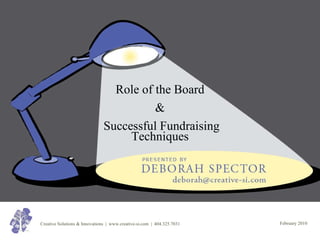Role of the board & successful fundraising techniques
•Transferir como PPT, PDF•
2 gostaram•2,809 visualizações
Role of the board & successful fundraising techniques inspires and encourages board members to support their organizations. How will your board members answer when asked what they do for the organization? You'll know you have a fundraising board when they proudly state they raise resources & influences for their organization.
Denunciar
Compartilhar
Denunciar
Compartilhar

Recomendados
Mais conteúdo relacionado
Mais procurados
Mais procurados (20)
Charity Pitch Deck & Investor Presentation - Sample PDF & Example

Charity Pitch Deck & Investor Presentation - Sample PDF & Example
Jewish Education Project - "Date your Donors" Course Part 2

Jewish Education Project - "Date your Donors" Course Part 2
How To Write An Inspiring Case For Support Rodrigo Alvarez

How To Write An Inspiring Case For Support Rodrigo Alvarez
Why You Should Approach Philanthropy Like A Business Exec

Why You Should Approach Philanthropy Like A Business Exec
Copy of 5 ways to enage your board members in fundraising 

Copy of 5 ways to enage your board members in fundraising
Destaque
Dan Gillett & Tim Kachuriak - Social Fundraising Strategy & Success Stories

Dan Gillett & Tim Kachuriak - Social Fundraising Strategy & Success StoriesSocial Media for Nonprofits
Destaque (20)
Crowdfunding Your Fundraising: Growing Your Donor Pipeline

Crowdfunding Your Fundraising: Growing Your Donor Pipeline
10 Fundraising Strategies PACs can Learn from Nonprofits (Part 1)

10 Fundraising Strategies PACs can Learn from Nonprofits (Part 1)
Strategic Communication/Fundraising Plan: Plant a Fish

Strategic Communication/Fundraising Plan: Plant a Fish
Dan Gillett & Tim Kachuriak - Social Fundraising Strategy & Success Stories

Dan Gillett & Tim Kachuriak - Social Fundraising Strategy & Success Stories
Fundraising Strategy - useful tools that really work

Fundraising Strategy - useful tools that really work
Proven Integrated Fundraising Techniques for Pet Rescues

Proven Integrated Fundraising Techniques for Pet Rescues
Make your donor the hero with your year-end fundraising campaign

Make your donor the hero with your year-end fundraising campaign
Fundraising Strategy - useful tools that really work IoF 2011

Fundraising Strategy - useful tools that really work IoF 2011
Nonprofit contact and donor relationship management (CRM)

Nonprofit contact and donor relationship management (CRM)
Integrating Social Media Into Your Fundraising Strategy

Integrating Social Media Into Your Fundraising Strategy
Semelhante a Role of the board & successful fundraising techniques
Starting a Major Gifts Program: Mining the Buried Treasure in Your Backyard (...

Starting a Major Gifts Program: Mining the Buried Treasure in Your Backyard (...United Way of the National Capital Area
Semelhante a Role of the board & successful fundraising techniques (20)
Starting a Major Gifts Program: Mining the Buried Treasure in Your Backyard (...

Starting a Major Gifts Program: Mining the Buried Treasure in Your Backyard (...
Recruiting and Building a Strong and Effective Board

Recruiting and Building a Strong and Effective Board
Working with your Board of Directors by Rachael Barrett

Working with your Board of Directors by Rachael Barrett
Mais de Deborah Spector
Mais de Deborah Spector (20)
Creating a Strategic Marketing Communications Plan

Creating a Strategic Marketing Communications Plan
Communications getting attention & enhancing your reputation

Communications getting attention & enhancing your reputation
Loud & Clear - Successfully Marketing your Nonprofit

Loud & Clear - Successfully Marketing your Nonprofit
Último
America Is the Target; Israel Is the Front Line _ Andy Blumenthal _ The Blogs...

America Is the Target; Israel Is the Front Line _ Andy Blumenthal _ The Blogs...Andy (Avraham) Blumenthal
Último (20)
Politician uddhav thackeray biography- Full Details

Politician uddhav thackeray biography- Full Details
Transformative Leadership: N Chandrababu Naidu and TDP's Vision for Innovatio...

Transformative Leadership: N Chandrababu Naidu and TDP's Vision for Innovatio...
Group_5_US-China Trade War to understand the trade

Group_5_US-China Trade War to understand the trade
America Is the Target; Israel Is the Front Line _ Andy Blumenthal _ The Blogs...

America Is the Target; Israel Is the Front Line _ Andy Blumenthal _ The Blogs...
Powerful Love Spells in Phoenix, AZ (310) 882-6330 Bring Back Lost Lover

Powerful Love Spells in Phoenix, AZ (310) 882-6330 Bring Back Lost Lover
THE OBSTACLES THAT IMPEDE THE DEVELOPMENT OF BRAZIL IN THE CONTEMPORARY ERA A...

THE OBSTACLES THAT IMPEDE THE DEVELOPMENT OF BRAZIL IN THE CONTEMPORARY ERA A...
Busty Desi⚡Call Girls in Sector 62 Noida Escorts >༒8448380779 Escort Service

Busty Desi⚡Call Girls in Sector 62 Noida Escorts >༒8448380779 Escort Service
Enjoy Night ≽ 8448380779 ≼ Call Girls In Gurgaon Sector 46 (Gurgaon)

Enjoy Night ≽ 8448380779 ≼ Call Girls In Gurgaon Sector 46 (Gurgaon)
WhatsApp 📞 8448380779 ✅Call Girls In Chaura Sector 22 ( Noida)

WhatsApp 📞 8448380779 ✅Call Girls In Chaura Sector 22 ( Noida)
Nara Chandrababu Naidu's Visionary Policies For Andhra Pradesh's Development

Nara Chandrababu Naidu's Visionary Policies For Andhra Pradesh's Development
Enjoy Night ≽ 8448380779 ≼ Call Girls In Gurgaon Sector 48 (Gurgaon)

Enjoy Night ≽ 8448380779 ≼ Call Girls In Gurgaon Sector 48 (Gurgaon)
KING VISHNU BHAGWANON KA BHAGWAN PARAMATMONKA PARATOMIC PARAMANU KASARVAMANVA...

KING VISHNU BHAGWANON KA BHAGWAN PARAMATMONKA PARATOMIC PARAMANU KASARVAMANVA...
Enjoy Night ≽ 8448380779 ≼ Call Girls In Palam Vihar (Gurgaon)

Enjoy Night ≽ 8448380779 ≼ Call Girls In Palam Vihar (Gurgaon)
Role of the board & successful fundraising techniques
- 1. Role of the Board & Successful Fundraising Techniques
- 2. Call To Action “ If you don’t know where you’re going it doesn’t matter which way you go!” Said the Cheshire Cat in Alice in Wonderland
- 17. Thank You!
